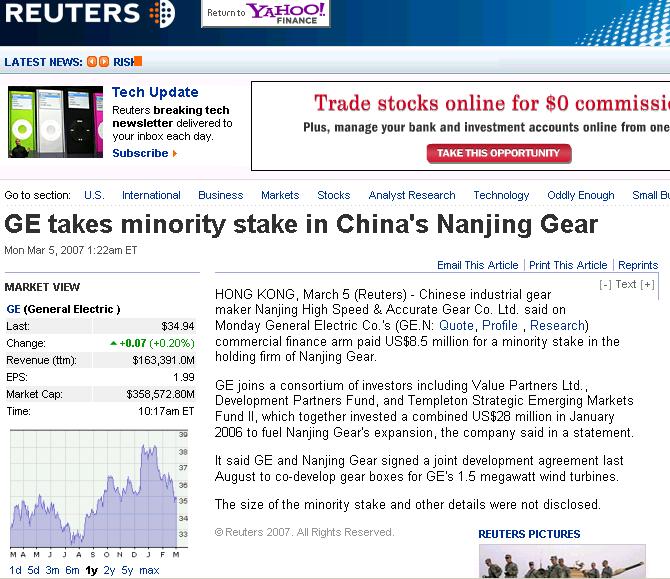SearchUser loginOffice of CitizenRest in Peace,
Who's new
|
GE REP ON CLEVE WIND "T-FORCE" - WHILE GE WIND MANUF. $ GO 2 CHINASubmitted by Jeff Buster on Mon, 03/05/2007 - 18:49.
 I still haven't read the "T Forces" reasons why wind turbines on Lake Erie are the first wind turbine development for Ohio in need of taxpayer subsidy study by Cuyahoga County (I have been a wind energy believer for 37 years, so take my cynicism here very seriously), but I was amused that David Rosenberg, Manager, Market Development for the Americas, GE Energy, was a member of the Technical Development Committee (see page 2 of pdf “members”) While GE is figuring out how to offshore to China the component manufacturing of their turbines, GE has their rep in NEO on the so called “task force” to figure out how to install turbines off of Cleveland in Lake Erie. Forget the installation of turbines in NEO, NEO needs the gearcase work. Why isn’t GE working with a Cuyahoga County “task force” to figure out why we can’t manufacture GE gearboxes right here in the USA? Why aren’t our political and civic representatives asking this question?
( categories: )
|
Recent commentsPopular contentToday's:All time:Last viewed:
Recent blog posts
|
Great point JB. I'll
Great point JB. I'll tell you why China, because they want near slave labor at a nickel a day working on their production lines, far away from public scrutiny and environmental regulations that drive down the amount of externalities and drive up ethical production.
So much for having a fair trade wind turbine gear box... or turbine at all.
Wikipedia's take on fair trade is as follows:
Definition of fair trade
The most widely recognized definition of fair trade was created by FINE, an informal Association of the four main fair trade networks (Fairtrade Labelling Organizations International, International Fair Trade Association, Network of European Worldshops and European Fair Trade Association):[4]
ZM
Doing well vs. Doing good
This gets to the heart of my problem with the concept of "sustainability" of doing good while doing well. I don't believe they are complimentary at all. If GE's objective is to do well, as is their shareholder obligation, GE will do whatever is legal to profit. There is no expectation they will do good - they do not have any shareholder obligation to do good for anyone. I don't hold that against them. But when a community is activated to support GE, and other do-wellers, on the hype it is about doing good, that is a misappropriation of public trust, under false pretenses. When a community puts their energy into helping industry do well, it is unrelated to doing good for the community. E.G., the City of Cleveland is not pursuing Sherwin Williams to do good by the community about the lead they "Covered the Earth" in because Cleveland wants Sherwin Williams to do well. It seems we have fallen into an odd state of being a community all about helping industry do well, and we are not doing good for the people of the community, and the community is not doing good or well. Perhaps there is a lesson to be learned in that.
Disrupt IT
interesting perspective
As Norm has specifically specified ... Sustainaibility does not have to entail doing good and doing well - but what many organizations are finding is unprecedented value when they MEANINGFULLY find ways to do so. As former HP-CEO Carly Fiorina put it 'Doing Good and Doing Well need not be mutually exclusive outcomes'. Norm makes excellent points from his perspective - but the most important aspect of Sustainability is that it is a holistic and integrative PROCESS and not a static entity. It refers quite simply in creating a generative process - one which does not compromise our future generations and their abilities to meet their needs. We need to function as an integrated, synergistic system so that all stakeholders who wish to effect sustainability and those who don't necessarily see this as valuable are empowered with the thought leadership and strategies to uplift the entire system that is Northeast Ohio - NEO.
The six-frame model (arts, education, economy, environment, health, technolgy) which comprises our core taxonomy on REALNEO was designed to demonstrate the key pillars that comprise our simple-yet-elegant way of representing holistic sustainable economic development. By facilitating progress and connectivity within and between these spheres we facilitate progress toward economic development. Value is found at the intersection between these diverse spheres - Ingenuity Festival celebrates, for example, the intersection between Art and Technology.
This year we are designing an homage to sustainability and 'A Sustainable Future' - to be featured throughout the first floor of the Nance Business School at CSU - so that it incorporates an organizational design I introduced at 2004 Research ShowCASE at CWRU. This Thompson Hine Award winner is serving us well as we cultivate and facilitate economic development engines (roundtables) that cluster thought leaders representative of several key technological sectors. This is all quite exciting and 7gen is proud to partake in this prolific production.